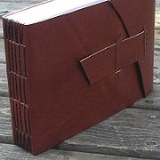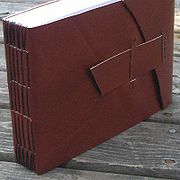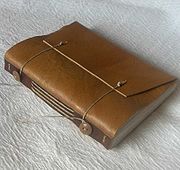
Long-stitch bookbinding
Encyclopedia
Longstitch is a bookbinding
technique used for sewing together the sections of a book. There are different forms of longstitch sewings. Longstitch binding does not require glue, though there are methods that utilize glue. In his book "Non Adhesive Bindings," Keith Smith describes the "Longstitch through a slotted cover" and it involves sewing each section directly through the cover where slots have been made at each sewing station. This sewing method creates a staggered line pattern visible on the spine. Keith Smith indicates that this type of longstitch was used as early as the 18th century in some parts of Europe, and possibly earlier.
 Another longstitch technique is done in conjunction with a chain stitch. This particular sewing method is very old and originated in Germany as early as the medieval era. In Szirmai's text, "The Archaeology of medieval bookbinding," the author describes this method of bookbinding
Another longstitch technique is done in conjunction with a chain stitch. This particular sewing method is very old and originated in Germany as early as the medieval era. In Szirmai's text, "The Archaeology of medieval bookbinding," the author describes this method of bookbinding
being used on parchment covered books with reinforced spines between 1375 and 1500. The sections were sewn directly through holes in the cover material, with two sections being sewn through each row of holes. This allowed the creation of a chain stitch at the first and last sewing stations.
 There are many ways to elaborate on the simple longstitch binding. Besides altering the stitching pattern to include crosses, altering the length of the longstitches to have their own patterns, and other patterns, artists have also used multiple colored thread. There are also a number of different ways to close a longstitch book. Though some longstitch bound book covers are just trimmed to the edge of the book block, there are a variety of ways to fold over one side of the cover and fasten it. Buttons can be stitched into the binding and a thread attached to the cover flap. A slit can also be cut into the front cover and a strip from the back cover can be slipped through the slit. Modern book artists have elaborated on closure styles.
There are many ways to elaborate on the simple longstitch binding. Besides altering the stitching pattern to include crosses, altering the length of the longstitches to have their own patterns, and other patterns, artists have also used multiple colored thread. There are also a number of different ways to close a longstitch book. Though some longstitch bound book covers are just trimmed to the edge of the book block, there are a variety of ways to fold over one side of the cover and fasten it. Buttons can be stitched into the binding and a thread attached to the cover flap. A slit can also be cut into the front cover and a strip from the back cover can be slipped through the slit. Modern book artists have elaborated on closure styles.
Bookbinding
Bookbinding is the process of physically assembling a book from a number of folded or unfolded sheets of paper or other material. It usually involves attaching covers to the resulting text-block.-Origins of the book:...
technique used for sewing together the sections of a book. There are different forms of longstitch sewings. Longstitch binding does not require glue, though there are methods that utilize glue. In his book "Non Adhesive Bindings," Keith Smith describes the "Longstitch through a slotted cover" and it involves sewing each section directly through the cover where slots have been made at each sewing station. This sewing method creates a staggered line pattern visible on the spine. Keith Smith indicates that this type of longstitch was used as early as the 18th century in some parts of Europe, and possibly earlier.

Bookbinding
Bookbinding is the process of physically assembling a book from a number of folded or unfolded sheets of paper or other material. It usually involves attaching covers to the resulting text-block.-Origins of the book:...
being used on parchment covered books with reinforced spines between 1375 and 1500. The sections were sewn directly through holes in the cover material, with two sections being sewn through each row of holes. This allowed the creation of a chain stitch at the first and last sewing stations.

Further reading
- Smith, Keith A. (1995). "Non Adhesive Binding, Vol. 1, Books Without Paste or Glue."keith a smith BOOKS (Rochester, NY).
- Smith, Keith A. (1995). "Non Adhesive Binding, Vol. 2, 1- 2- and 3-Section Sewings."keith a smith BOOKS (Rochester, NY).
- Smith, Keith A. (1995). "Non Adhesive Binding, Vol. 3, Exposed Spine Sewings."keith a smith BOOKS (Rochester, NY).
- Smith, Keith A. (2001). "Non Adhesive Binding, Vol. 4, Smith's Sewing Single Sheets."keith a smith BOOKS (Rochester, NY).
- Smith, Keith A. (2003). "Quick Leather Bindings, Non Adhesive Binding, Volume 5."keith a smith BOOKS (Rochester, NY).

